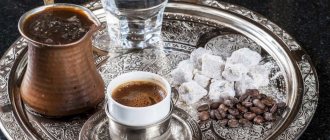Lemon tart goes well with espresso from Colombia, and berry sorbet goes with filter coffee from Rwanda.
Coffee is a product with a subtle aroma and taste, so it does not need any additions - this is what fighters for purity of taste believe. For a long time, an eclair with a cappuccino or a sandwich with filter coffee was considered bad manners among “coffee purists,” but new research is changing everything. Coffee, like wine, can and should be combined with different foods, sometimes in unexpected combinations. We figure out how to do it correctly and get inspired by examples of ideal couples. It will be delicious!
A Brief History of Coffee Culture
Perhaps the best way to start a conversation about food pairing with coffee is to talk about how society's attitude towards coffee has changed over time.
To explain the recent interest in coffee pairings, we need to understand the evolution of coffee consumption—also referred to as the first, second, and third waves of coffee.
In the first wave of coffee, producers were focused on creating a standard coffee taste and aroma. All coffees were the same and, as a result, consumers perceived no difference between the different bean profiles. The first wave generation tried to get rid of the unique characteristics of coffee beans, creating a generic coffee industry that was perfect for the mass market.
The second wave of the coffee industry was focused on repositioning coffee as a drink that gives a unique taste experience, so coffee companies began to talk about themselves, the manufacturer, the country of origin, coming to the understanding that these are some of the main factors influencing the taste of coffee.
The third wave of coffee began to pave the way for coffee pairings as companies began creating different flavor profiles. Instead of perceiving a drink as a source of one taste and aroma, we can now appreciate a whole variety of aromas and taste sensations and pair them with certain foods.
You can also read more about coffee culture in our full article.
Coffee without sugar for weight loss
When glucose enters the body, the nutrient is quickly absorbed in the small intestine. As a result, blood sugar levels rise and a feeling of fullness occurs. After drinking coffee without adding granulated sugar, a similar phenomenon is observed. Moreover, after 1 cup of a tart drink, the body receives only a few calories. A person feels falsely full due to the fat-burning properties of caffeine.
The active substance in coffee beans stimulates the breakdown of fat deposits in the subcutaneous tissue and activates the breakdown of glycogen in the liver and skeletal muscles. The latter is formed in hepatocytes from glucose and other simple carbohydrates. Therefore, after its breakdown, a large amount of sugar is released into the blood. To regulate glucose concentrations, the pancreas begins to actively produce insulin.
When the islets of Langerhans are activated, sensory neurons transmit information to the brain about high blood sugar levels. As a result, the excitability of the food center decreases, appetite decreases, and the process of weight loss occurs.
Nutritionists do not object to the use of this method of combating excess weight, but they do not recommend drinking coffee without sugar after meals. Under the influence of caffeine, metabolic processes in the body are accelerated, which is why the digestion process is 40% faster. Under such conditions, nutrients are less well absorbed, which can cause disruption of the functioning of internal organs. In addition, the feeling of fullness occurs for a short time. Within an hour, a person will want to eat again, which can provoke a breakdown during weight loss.
In the fight against excess weight, green coffee is drunk in the form of capsules. The medicine contains an extract of sprouted coffee beans with a high concentration of chlorogenic acid. The active compound stimulates the breakdown of fat masses, which helps accelerate weight loss while following a low-calorie diet.
Adding spices to a drink when losing weight is not prohibited. 1 g of dried ginger root or cinnamon increases the nutritional value of the product by 2.5-3.5 kcal.
How to approach coffee pairings
The first step is to determine which flavors dominate the food. What ingredients and flavors stand out the most? A successful combination should strengthen them.
Next, pay attention to the temperature and texture of the food. These two factors play the most important role in how the dish will feel in the mouth and, therefore, how the coffee will pair with it.
It's important to think about the time of day and the situation in which you prepare coffee and serve food, because coffee brewed on a Sunday morning will not pair with the same food as an espresso taken on the run to work.
Each of these principles can be used when selecting food not only for coffee, but also for tea, wine and beer.
Toppings and syrups
The variety of coffee tastes today is so great that you can no longer deny yourself the pleasure of turning natural black coffee into an exotic dessert. A couple of teaspoons of syrup or topping and you're in heaven. Espresso, latte or cappuccino play with completely new colors and awaken your imagination. What is coffee syrup? This is a concentrate of sugar, water, fruits, spices. The syrup is mixed with the drink, highlighting its taste favorably. Topping translated from English is the top. This additive does not dissolve in coffee and remains on the surface. It is thick, similar in consistency to sauce. It is used not only to provide a special taste, but also to decorate coffee. Most often the topping is combined with whipped cream.
Why do some combinations work and others don't?
Food and drinks are made up of certain components and substances, each of which has specific characteristics that affect texture, taste, and aroma. If the combination works, it is because the individual characteristics have been identified and "crossed" successfully. A good result can be achieved by two methods: contrasting or imitation.
Contrast balances the flavors. For example, hazelnut cookies are an excellent pairing for espresso. The sweet, nutty flavor complements the dark chocolate and caramel notes often found in espresso.
The imitation method works on the principle of enhancing taste. A common example is a sweet dessert paired with dessert wine or liqueur that is sweeter than the dish itself. With coffee and cake, you can imitate the fruity notes of the drink in fruit desserts: blueberry muffin or lemon tart.
Now we know the theory, but what about practice? To understand how it all works in life, we asked a couple of questions to the experts: Anna Valiotti from the True Coffee team.
Anna Valiotti, soul of True Coffee
What do you need to know about coffee for food pairing?
“You need to take into account the texture and taste of the coffee: is it sour or more tart. Coffee can also have different shades of fruity aromas: some are quite distinctly lemon or grapefruit, and some are sweet fruits and berries like cherries, pears or apricots. I would advise pairing these flavors with foods with a dense texture, such as chocolate cakes.
The most important factor to consider is balance. Food and coffee should not “compete”, but should complement each other to create a harmonious taste.”
What are your favorite coffee combinations?
“The choice of coffee and food in my case correlates with the mood and state in which I am. But for as long as I can remember, I have always loved coffee with cheese! Our nutty, dense, creamy varieties - Espresso, Peru, Brazil - go well with cheese. I like to experiment - not only brew the same type of coffee in different ways, but also combine it with different products. I usually prefer citrus coffee for dessert, such as Ethiopia Yirgacheffe. But on melancholy winter days I don’t want sourness at all, so I complement the dessert with a sweet cappuccino with Guatemala.”
Together we have also compiled a guide to the most successful and common combinations.
Fruit combinations
- Berries – Kenyan coffee is best with any berry.
- Fruit tarts taste exceptional when paired with Brazilian coffee.
Chocolate combinations
- Chocolate and coffee are an established and favorite combination. Works great with lattes and ristrettos.
- Brownies - rich varieties like Guatemala are suitable.
- Chocolate cakes - go well with medium roast coffee, especially if it's Guatemala. Chocolate mousses will be good with any Arabica coffee.
- Chocolate covered fruit - complements most African coffees, such as Ethiopia.
- Dark chocolate goes well with Brazilian, Ethiopian and Guatemalan coffee.
- Milk chocolate - it’s difficult to single out any specific varieties, because the combinations with any coffee are good, but still coffee from Colombia, Kenya and Ethiopia will be the most striking partner.
- White chocolate - we recommend Colombia.
Baking combinations
In Italy it’s coffee and cookies, in Canada and America it’s donuts for coffee. Let's look at a few more special combinations.
- Cinnamon rolls - The caramel and chocolate notes of Colombian and Guatemalan coffee are the best.
- Croissants - combined with coffee, they are simply an icon of French restaurant culture. Any combination will do, but for a more interesting taste, try making coffee with milk.
- Muffins - according to many, Mexican coffee complements this dessert best.
For those who want the least familiar combinations, we recommend experimenting with cheese (German and Swiss are best), Frankfurt sausages, bacon (in any form: fried, in a sandwich, in a roll).
Now you know that coffee is not only about the usual combinations like sweets and chocolate, there is a lot of room for imagination. Experiment with coffee and find successful and unusual combinations!
Coffee and fruits, nuts
Coffee and avocado. This combination may be unlikely for Western tastes, but remember, avocado is a fruit, and it is considered as such in Vietnam, Indonesia and the Philippines. This means that it can be pureed with milk, or with sugar, or with condensed milk, and sometimes with coffee or chocolate flavored syrup.
Coffee and orange
Coffee and cherry
Coffee and banana. Coffee contains highly volatile aldehydes and esters, which impart floral notes and hints of sweet spices such as cloves. The banana also has floral and clove components, so the two flavors come together in a satisfying unity. Note that coffee and bananas will not only impart their flavors to the dessert, but will also generate bitterness and acidity, which will counteract the desire of the dessert (like banoffee) to become sickly sweet - to the point of causing a headache.
Coffee and black currant. A surprisingly good pairing that is often mentioned at wine tastings. It’s worth trying this combination in a Pavlova cake (pavlova – meringue with coffee cream and a rather sweet blackcurrant infusion) or even putting blackcurrant jam in a coffee gateau.
Coffee and almonds. Roasted coffee has a very complex flavor, with one of its most desirable characteristics being a nutty flavor. Perhaps this circumstance can explain why coffee so often pairs with nuts. The most common coffee partner in this pairing is the walnut (see Coffee and Walnuts), but pairings of coffee with almonds (or marzipan) are also typical. Even if you don't find almonds in your usual cup of coffee, you can always enjoy communicating with this couple by taking a plump croissant with almonds, generously sprinkled with powdered sugar.
Coffee and hazelnuts. In case you find yourself in a good ice cream parlor and have trouble choosing, remember the mantra: “Coffee and hazelnuts, coffee and hazelnuts, coffee and hazelnuts!”
Customer reviews: 49, Article rating: 0.0
More and more, people are beginning to realize the huge differences in the aroma and taste of coffee depending on its place of origin, processing method and brewing. But what we often miss is how we can pair the drink with different dishes, snacks and sweets to get an even stronger flavor.
Today, many people know what to look for when choosing food to go with wine. The principles of pairing were established here quite a long time ago, thanks to the properties of wine and complementary dishes that enhance each other’s taste characteristics. Coffee is not much different and, with skill, can be combined with food to create a new and unexpected twist in taste.
Try our coffee
Mix of grains
Espresso coffee
Blend of 100% Arabica beans. The aroma reveals notes of roasted peanuts and hazelnuts, while the taste is dominated by dark chocolate and walnuts. Soft aftertaste of cocoa and burnt sugar.
Peru
Coffee "Chanchamayo"
Rich and strong coffee with notes of bread in the aroma.
Brazil
Coffee "Santos"
The aroma is dominated by spices and cocoa. The soft nutty-chocolate taste is offset by a slight sourness at the end.











